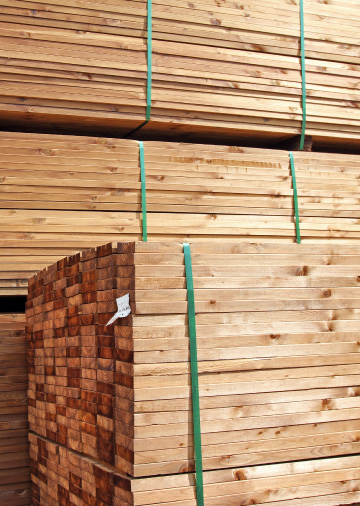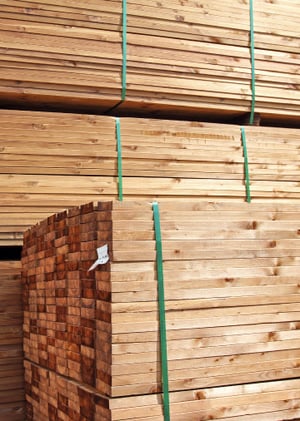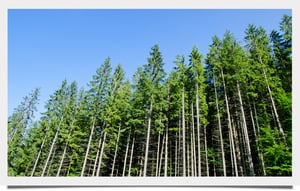4 min read
Forest2Market CEO Pete Stewart Talks Lumber, Forest Health on NPR’s Marketplace
Forest2Market
:
July 14, 2020

North American finished lumber prices have skyrocketed since the COVID-19 pandemic gripped the global economy in March, and market analysts are taking notice.
A recent episode of the nationally syndicated radio show Marketplace, which airs daily in many National Public Radio (NPR) markets, tackled the subject by interviewing Greg Kuta, a lumber futures trader, and Forest2Market CEO Pete Stewart.
What’s happening in the lumber market that has piqued the interest of so many? As always, it’s about supply, demand, and price.
Widespread mill closings and curtailments that took effect across North America in March pinched the flow of finished lumber inventories so significantly that prices shot up for nine straight weeks as a reaction. Prices have now eclipsed the historic highs reached in 2018.
Now, as construction crews in “non-essential” states have played catch up in recent weeks and are getting back to work in earnest, demand for lumber has continued to drive prices ever higher. Manufacturers are cautiously watching the new housing market and ramping up capacity to meet the needs of builders.
- After two months of record-breaking declines, privately-owned housing starts were up 4.3 percent in May to a seasonally adjusted annual rate (SAAR) of 974,000 units.
- As an indicator of potential builds in the near-term, housing authorizations jumped 14.4 percent to a rate of 1.220 million units in May.
As the host of Marketplace notes in the radio segment, the perception of surging demand for wood products may cause some to worry about deforestation. But these fears are largely reactionary and overblown. Stewart adds, “In the U.S., we’re growing 15% to 20% more trees than we are consuming, which is good for the environment, good for everything.”
In fact, statistics on forest health prove that America’s working forests have never been more vibrant.
Forest2Market has demonstrated through its independent analytical work that economic and environmental interests tend to work in concert more often than not. Our policy support work has shown direct statistical correlations between healthy commercial markets for wood products and an increase in forest inventory and carbon sequestration, not the opposite.
How do we know this?
Most opponents of forest utilization have an incorrect view that timberland is a pristine, untouched reserve in a static state. However, the manufacture of wood products continues to support our society in many beneficial ways: housing/building products, paper products, energy, textiles, chemicals, and a myriad of other products. In the US South—which is the most active wood basin in the world—the majority of timberland is owned by private individuals.
Because of concerns about the growth of the wood products industry in the US, Forest2Market was commissioned to examine the history and sustainability of US forest assets as policy support in 2017. For the study, we conducted a statistical analysis for a 70-year period of the forest acreage, demand and inventory, and we found some counter intuitive, but statistically significant, correlations.
Over the period from 1953-2015 in the US South, our analysis showed the following:
- As demand for forest products has increased, timberlands in the US South have become increasingly productive. Between 1953 and 2015, annual removals—driven by demand—increased 57 percent from 5.5 to 8.7 billion cubic feet. Simultaneously, annual growth increased 112 percent from 6.8 to 14.4 billion cubic feet.
- Increased demand for wood has not depleted forests. The amount of timberland—unreserved, productive forest land—in the US South has remained stable, increasing by about 3 percent. Because annual growth has outpaced annual removals by an average of 38 percent (GRR=1.38), inventory increased 108 percent from 142.1 to 296.1 billion cubic feet.

- Removals increased as consumer demand for wood products grew. Population growth, higher real Gross Domestic Product and greater utilization of wood for housing construction during periods of economic expansion spurred demand for forest products, including lumber, wood panels, pulp and paper products.
- Landowners responded to greater demand by investing in the future growth of their forests. The forest products industry played a critical role in promoting increases in forest productivity by funding public-private research projects to improve tree genetics and update silvicultural practices, which increased growth and yield, especially on plantation stands. Consistent and increasing demand for forest products assured other private landowners that engaging in more active (and expensive) management practices would provide financial dividends, which ensured more widespread adoption of improved management practices.
- The evidence is clear: Increases in removals are associated with more timberland acres, better growth and larger inventories. Removals have strong, positive, statistically significant correlations with acres, inventory and growth. Regression models that use removals to predict these measures of forest productivity are statistically significant and explain from 65 to 90 percent of the variance in acres, inventory and growth.
- Case study evidence confirms that increased removals are associated with increased inventory not only at a regional scale, but also in local wood basins. Further, they demonstrate that the markets in local wood basins are defined not by changes in demand from a single mill, but rather market-wide shifts in the demand for all wood products, especially sawtimber. However, the case studies also show that when these basins had an active, centrally located pulpwood-consuming mill, plantation acres increased more quickly, which helped retain total timberland acres in the face of declining naturally-regenerated timberlands.
- Today, the biggest threat to forests is urbanization, but this threat can be mitigated by healthy markets for forest products, especially for products from highly productive plantations. Nationwide, between 1982 and 2012, development was responsible for almost half (49.2 percent or 17.7 million acres) of all forest land that converted to other land uses. Conversely, forests reclaimed very little (1.2 percent or 0.5 million acres) from developed areas. In the US South, the most productive plantation stands are best protected against conversion: Between 1989 and 1999, 5.4 million acres of stocked timberlands converted to non-forest uses. Of those that did, the overwhelming majority (94 percent) were naturally regenerated forests, not planted stands.
Forest2Market very much appreciates Marketplace’s willingness to engage in a fair and fact-based discussion about the lumber industry, as well as its impact on America’s forests.





